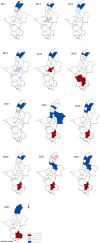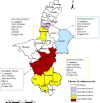Prevalence and Spatial distribution characteristics of human echinococcosis in Ningxia Hui Autonomous Region, 2011-2023
- PMID: 40739204
- PMCID: PMC12309093
- DOI: 10.1186/s12889-025-23740-x
Prevalence and Spatial distribution characteristics of human echinococcosis in Ningxia Hui Autonomous Region, 2011-2023
Abstract
Background: Echinococcosis is a zoonotic parasitic disease caused by tapeworms of the genus Echinococcus that endangers public health and hinders socioeconomic development. Ningxia Hui Autonomous Region(Ningxia) is one of the primary locations where this disease is endemic. This study analyzed the prevalence and spatial distribution characteristics of human echinococcosis in Ningxia from 2011 to 2023, providing a reference for identifying key areas of human echinococcosis and developing targeted prevention and control strategies.
Methods: Data on human echinococcosis in Ningxia from 2011 to 2023 were collected from "China Information System for Disease Control and Prevention". The population data were obtained from the official website of the Ningxia Statistical Bureau. Joinpoint regression analysis was used to characterize the incidence trend of human echinococcosis in Ningxia. County-level electronic maps of Ningxia were downloaded from the National Geographic Information Public Service Platform. The epidemiological characteristics of human echinococcosis were analyzed, and spatial autocorrelation analysis was performed using ArcGIS 10.4 software. Additionally, spatiotemporal scanning analysis was conducted using SaTScan V9.5 software.
Results: A total of 3,316 cases of human echinococcosis were reported from 2011 to 2023.The annual average incidence of the disease was 3.88 per 100,000 persons, with the highest rate of 6.38/100,000 in 2012 and the lowest rate of 1.33/100,000 in 2023. The incidence rate of human echinococcosis showed a declining trend, with average annual percent change (AAPC) of -11.27% (95% CI: -15.50% to -6.83%; t = -4.80, P < 0.001). Of the total cases, 1,566 were male and 1,750 were female. The male-to-female ratio is 0.89:1, with the incidence rate lower in males (3.48 per 100,000) than in females (4.06 per 100,000). The incidence rate was highest in the 70-year age group (17.00 per 100,000), followed by the 60-year age group (10.84 per 100,000), while the lowest incidence was observed in the 0-year age group (0.09 per 100,000). These data demonstrate a clear age-dependent increasing trend in human echinococcosis incidence rate(χ2 = 4172.53; P < 0.001). The global spatial autocorrelation analysis results revealed that human echinococcosis incidence rate exhibited spatial clustering between 2015 and 2019 and 2021-2023. Local spatial autocorrelation analyses revealed that the "high-high" clustered area was mainly located in southern Ningxia, specifically in Yuanzhou District, Haiyuan County, Hongsibao District and Pengyang County. Additionally, spatial scanning analysis identified four spatial clusters, including one most likely cluster(LLR = 335.53, RR = 4.13, P<0.01)and three secondary likely clusters.
Conclusion: This study is based on Ningxia's echinococcosis surveillance data from 2011 to 2023. It was confirmed through spatial epidemiological analysis that the national central transfer payment prevention and control project can effectively reduce the rate of echinococcosis infection in the population. The spatial clustering characteristics found in the study (high-high clustering areas are concentrated in the southern mountainous areas, and low-low clustering areas are located in the northern and central areas) provide a scientific basis for differentiated prevention and control strategies. It is recommended to use "patient tracking + key population monitoring" instead of whole-region screening, focusing health resources on key areas and key populations, and maximizing prevention and control efficiency.
Keywords: Echinococcosis; Epidemiological characteristics; Ningxia; Spatial autocorrelation; Spatial scan clustering.
© 2025. The Author(s).
Conflict of interest statement
Declarations. Ethics approval and consent to participate: This study has received ethical approval from the Ningxia Center for Disease Control and Prevention Ethics Committee with IRB the number 2025-LLSC-123.The Prior to including all participants in the study, their informed consent was obtained. This process follows the ethical principles outlined in the Declaration of Helsinki. Consent for publication: Not applicable. Competing interests: The authors declare no competing interests.
Figures





Similar articles
-
Spatiotemporal distribution of newly diagnosed echinococcosis patients in Sichuan Province, China, 2013-2024.PLoS Negl Trop Dis. 2025 Aug 4;19(8):e0013358. doi: 10.1371/journal.pntd.0013358. eCollection 2025 Aug. PLoS Negl Trop Dis. 2025. PMID: 40758727 Free PMC article.
-
Epidemiological changes in tuberculosis and genotyping characteristics of Mycobacterium Tuberculosis in Ningxia, China.Front Microbiol. 2025 Jun 4;16:1582163. doi: 10.3389/fmicb.2025.1582163. eCollection 2025. Front Microbiol. 2025. PMID: 40535020 Free PMC article. Review.
-
Epidemiological characteristics and spatial clustering analysis of human brucellosis in Zibo City, Shandong Province, China, 2006-2024.Front Public Health. 2025 Jun 27;13:1580265. doi: 10.3389/fpubh.2025.1580265. eCollection 2025. Front Public Health. 2025. PMID: 40655220 Free PMC article.
-
Analysis of the Spatiotemporal Distribution and Evolutionary Trends of Scrub Typhus in Jiangsu Province from 2006 to 2023.J Epidemiol Glob Health. 2025 Aug 25;15(1):110. doi: 10.1007/s44197-025-00450-6. J Epidemiol Glob Health. 2025. PMID: 40853578 Free PMC article.
-
Interventions targeted at women to encourage the uptake of cervical screening.Cochrane Database Syst Rev. 2021 Sep 6;9(9):CD002834. doi: 10.1002/14651858.CD002834.pub3. Cochrane Database Syst Rev. 2021. PMID: 34694000 Free PMC article.
References
-
- Autier B, Gottstein B, Millon L, Ramharter M, Gruener B, Bresson-Hadni S, et al. Alveolar echinococcosis in immunocompromised hosts. Clin Microbiol Infect. 2023;29(5):593–9. 10.1016/j.cmi.2022.12.010. Epub 20221215. - PubMed
-
- Denzinger M, Nasir N, Steinkraus K, Michalski C, Hüttner FJ, Traub B. Treatment concepts for hepatic echinococcosis. Chirurgie (Heidelb). 2023;94(6):560–70. 10.1007/s00104-023-01825-w. PubMed PMID: 36853342. - PubMed
MeSH terms
Grants and funding
LinkOut - more resources
Full Text Sources

